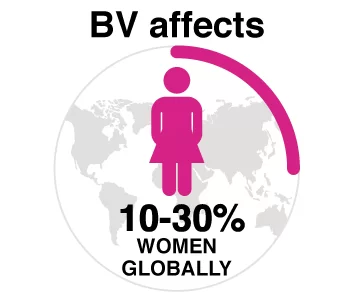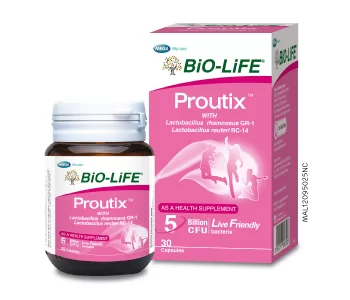
Bacterial Vaginosis and How It Affects Women’s Health
Nov 1, 2022
What is Bacterial Vaginosis (BV)?
Bacterial Vaginosis (BV) is a vaginal inflammation that occurs due to an overgrowth of bad bacteria (e.g. Gardnerella vaginalis, Prevotella sp, Mobiluncus sp, Ureaplasma sp, Mycoplasma hominis).
How did BV happen?
In a healthy women’s vagina, it consists of a healthy balance of beneficial bacteria (generally dominated by lactobacillus) that helps to maintain a healthy vaginal environment and prevent vaginal infections.
However, in BV, the excessive growth of bad bacteria overtakes the population of beneficial bacteria, resulting in the disruption of the natural microbiota balance in the vagina, thus reducing the amount of lactobacillus and their protective effects. This is also one of the most common causes of vaginal discharge and vaginal infection among women in their reproductive age. 1,2,3
How does it affect you?

50% of BV patients show no symptoms 3, but when present, they may have itchiness at the vaginal area and/or burning sensation when urinating. Thin uniform white/grey discharge with fishy odor may also present, which intensifies during menstruation or after sexual intercourse. The offensive smelling discharge is due to amine production from bad bacteria, which also raises vaginal pH to ≥4.5.
For pregnant women who are contracted with BV, they are posed with a risk of premature delivery, low birth weight baby or miscarriage.2
Prevalence of BV


Am I at risk?
BV is common among women in their reproductive age (15-44 years old),5 however, women of any age can contract BV. You are at a higher risk if you have
- Vaginal pH≥ 4.5
- Smoke
- Frequent vaginal douching
- Use of overly scented soaps
- Wiping from back to front
- Use of IUCD (Intrauterine Contraceptive Device)
- Has multiple sex partners
- Natural lack of lactobacilli bacteria
How can probiotics help in preventing or treating BV?
Taking probiotics can help in replenishing beneficial bacteria and restoring the disrupted balance of vaginal microbiota. Study showed that 4 weeks oral consumption of Lactobacillus rhamnosus GR-1 and Lactobacillus reuteri RC-14 has significantly increase lactobacillus population (beneficial bacteria) in the vaginal flora.6 It can help in protecting vaginal health via a few mechanisms: 7,8
- Maintain vaginal acidity at pH 3.8-4.4 that favours the growth of beneficial bacteria but detrimental to the growth of bad bacteria
- Form a natural barrier against bad bacteria at the surface of the vaginal wall
- Produce antimicrobial substances and hydrogen peroxide that kill bad bacteria

BiO-LiFE Proutix contains both widely researched probiotics strains L. rhamnosus GR-1 and L. reuteri RC-14. It is a probiotics supplement specially formulated to improve women’s health.
References
- Vaginal Discharge. PORTAL MyHEALTH. 2019. Retrieved from: http://www.myhealth.gov.my/en/vaginal-discharge/
- Mokhtar N. Bacterial vaginosis, a common vaginal infection that is often being misdiagnosed. The Star Online. 2019. Available from: https://www.thestar.com.my/lifestyle/
health/2019/11/25/this-common-vaginal-infection-is-not-wellknown - Vaginitis: Trichomoniasis, Candidiasis, Bacterial Vaginosis. MIMS Malaysia. Retrieved from: https://specialty.mims.com/vaginitis–%20trichomoniasis,%20candidiasis,
%20bacterial%20vaginosis/signs%20and
%20symptoms?channel=infectious-diseases - Bradshaw C, Morton A, Hocking J, Garland S, Morris M, Moss L, et. Al. (2006). High Recurrence Rates of Bacterial Vaginosis over the Course of 12 Months after Oral Metronidazole Therapy and Factors Associated with Recurrence. The Journal of Infectious Diseases. 193(11):1478-86.
- Bacterial Vaginosis. CDC. 2020. Retrieved from: https://www.cdc.gov/std/bv/stdfact-bacterial-vaginosis.htm
- Reid, G., Charbonneau, D., Erb, J., Kochanowski, B., Beuerman, D., Poehner, R., & Bruce, A. W. (2003). Oral use of Lactobacillus rhamnosus GR-1 and L. fermentum RC-14 significantly alters vaginal flora: randomized, placebo-controlled trial in 64 healthy women. FEMS Immunology & Medical Microbiology, 35(2), 131-134.
- McFarland, L. V. (2009). Normal flora: diversity and functions. Microbial ecology in health and disease
- Bruce, A.W. Lactobacillus rhamnosus GR-1, Lactobacillus reuteri RC-14: rationale and clinical research of probiotic strains



